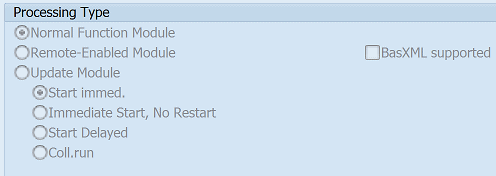SAP TR_SYS_PARAMS Function Module for Determine System Name, Type, Change Option
TR_SYS_PARAMS is a standard tr sys params SAP function module available within SAP R/3 or S/4 Hana systems, depending on your version and release level. It is used for Determine System Name, Type, Change Option processing and below is the pattern details for this FM, showing its interface including any import and export parameters, exceptions etc. there is also a full "cut and paste" ABAP pattern code example, along with implementation ABAP coding, documentation and contribution comments specific to this or related objects.
See here to view full function module documentation and code listing for tr sys params FM, simply by entering the name TR_SYS_PARAMS into the relevant SAP transaction such as SE37 or SE38.
Function Group: STR9
Program Name: SAPLSTR9
Main Program: SAPLSTR9
Appliation area: S
Release date: 26-Mar-1998
Mode(Normal, Remote etc): Remote-Enabled
Update:

Function TR_SYS_PARAMS pattern details
In-order to call this FM within your sap programs, simply using the below ABAP pattern details to trigger the function call...or see the full ABAP code listing at the end of this article. You can simply cut and paste this code into your ABAP progrom as it is, including variable declarations.CALL FUNCTION 'TR_SYS_PARAMS'"Determine System Name, Type, Change Option.
IMPORTING
SYSTEMEDIT = "System Change Option
SYSTEMNAME = "System Name (e.g. C11)
SYSTEMTYPE = "System Type ('SAP' or 'CUSTOMER')
SYSTEM_CLIENT_EDIT = "Change Option for Client-Dependent Customizing Objects
SYS_CLIINDDEP_EDIT = "Change Option for Repository Objects in Logon Client
SYSTEM_CLIENT_ROLE = "Client Role (see Documentation)
EV_SFW_BCSET_REC = "Recording Client for Switch BC Sets
EV_C_SYSTEM = "Obsolete: Always returned empty
EXCEPTIONS
NO_SYSTEMNAME = 1 NO_SYSTEMTYPE = 2
EXPORTING Parameters details for TR_SYS_PARAMS
SYSTEMEDIT - System Change Option
Data type: TADIR-EDTFLAGOptional: No
Call by Reference: No ( called with pass by value option)
SYSTEMNAME - System Name (e.g. C11)
Data type: SY-SYSIDOptional: No
Call by Reference: No ( called with pass by value option)
SYSTEMTYPE - System Type ('SAP' or 'CUSTOMER')
Data type: SY-SYSIDOptional: No
Call by Reference: No ( called with pass by value option)
SYSTEM_CLIENT_EDIT - Change Option for Client-Dependent Customizing Objects
Data type: T000-CCCORACTIVOptional: No
Call by Reference: No ( called with pass by value option)
SYS_CLIINDDEP_EDIT - Change Option for Repository Objects in Logon Client
Data type: T000-CCNOCLIINDOptional: No
Call by Reference: No ( called with pass by value option)
SYSTEM_CLIENT_ROLE - Client Role (see Documentation)
Data type: T000-CCCATEGORYOptional: No
Call by Reference: No ( called with pass by value option)
EV_SFW_BCSET_REC - Recording Client for Switch BC Sets
Data type: T000-CCORIGCONTOptional: No
Call by Reference: No ( called with pass by value option)
EV_C_SYSTEM - Obsolete: Always returned empty
Data type: TRPARI-S_CHECKEDOptional: No
Call by Reference: No ( called with pass by value option)
EXCEPTIONS details
NO_SYSTEMNAME - System name cannot be determined or invalid length
Data type:Optional: No
Call by Reference: No ( called with pass by value option)
NO_SYSTEMTYPE - System type cannot be determined
Data type:Optional: No
Call by Reference: No ( called with pass by value option)
Copy and paste ABAP code example for TR_SYS_PARAMS Function Module
The ABAP code below is a full code listing to execute function module POPUP_TO_CONFIRM including all data declarations. The code uses the original data declarations rather than the latest in-line data DECLARATION SYNTAX but I have included an ABAP code snippet at the end to show how declarations would look using the newer method of declaring data variables on the fly. This will allow you to compare and fully understand the new inline method. Please note some of the newer syntax such as the @DATA is not available until a later 4.70 service pack (SP8), which i why i have stuck to the origianl for this example.| DATA: | ||||
| lv_systemedit | TYPE TADIR-EDTFLAG, " | |||
| lv_no_systemname | TYPE TADIR, " | |||
| lv_systemname | TYPE SY-SYSID, " | |||
| lv_no_systemtype | TYPE SY, " | |||
| lv_systemtype | TYPE SY-SYSID, " | |||
| lv_system_client_edit | TYPE T000-CCCORACTIV, " | |||
| lv_sys_cliinddep_edit | TYPE T000-CCNOCLIIND, " | |||
| lv_system_client_role | TYPE T000-CCCATEGORY, " | |||
| lv_ev_sfw_bcset_rec | TYPE T000-CCORIGCONT, " | |||
| lv_ev_c_system | TYPE TRPARI-S_CHECKED. " |
| CALL FUNCTION 'TR_SYS_PARAMS' "Determine System Name, Type, Change Option |
| IMPORTING | ||
| SYSTEMEDIT | = lv_systemedit | |
| SYSTEMNAME | = lv_systemname | |
| SYSTEMTYPE | = lv_systemtype | |
| SYSTEM_CLIENT_EDIT | = lv_system_client_edit | |
| SYS_CLIINDDEP_EDIT | = lv_sys_cliinddep_edit | |
| SYSTEM_CLIENT_ROLE | = lv_system_client_role | |
| EV_SFW_BCSET_REC | = lv_ev_sfw_bcset_rec | |
| EV_C_SYSTEM | = lv_ev_c_system | |
| EXCEPTIONS | ||
| NO_SYSTEMNAME = 1 | ||
| NO_SYSTEMTYPE = 2 | ||
| . " TR_SYS_PARAMS | ||
ABAP code using 7.40 inline data declarations to call FM TR_SYS_PARAMS
The below ABAP code uses the newer in-line data declarations. This allows you to see the coding differences/benefits of the later inline syntax. Please note some of the newer syntax below, such as the @DATA is not available until 4.70 EHP 8.| "SELECT single EDTFLAG FROM TADIR INTO @DATA(ld_systemedit). | ||||
| "SELECT single SYSID FROM SY INTO @DATA(ld_systemname). | ||||
| "SELECT single SYSID FROM SY INTO @DATA(ld_systemtype). | ||||
| "SELECT single CCCORACTIV FROM T000 INTO @DATA(ld_system_client_edit). | ||||
| "SELECT single CCNOCLIIND FROM T000 INTO @DATA(ld_sys_cliinddep_edit). | ||||
| "SELECT single CCCATEGORY FROM T000 INTO @DATA(ld_system_client_role). | ||||
| "SELECT single CCORIGCONT FROM T000 INTO @DATA(ld_ev_sfw_bcset_rec). | ||||
| "SELECT single S_CHECKED FROM TRPARI INTO @DATA(ld_ev_c_system). | ||||
Search for further information about these or an SAP related objects